Matcha
Why Does Matcha Tastes Like Grass? Find Out!
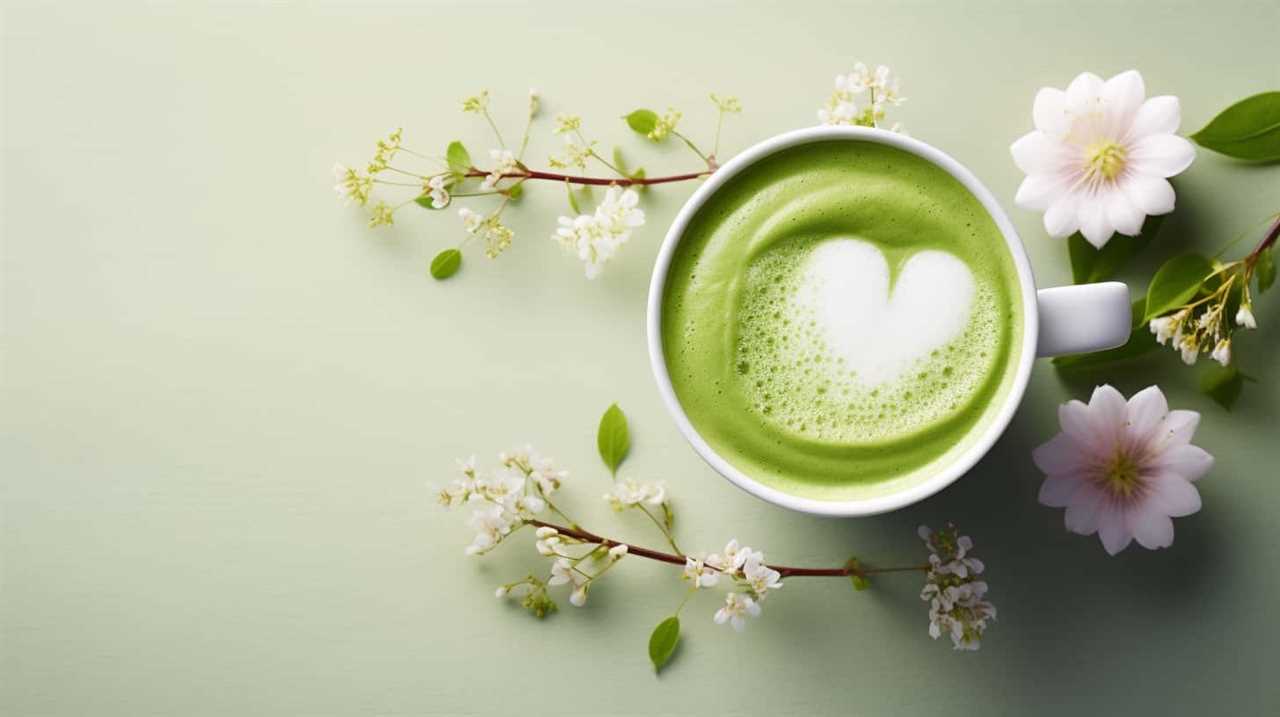
Have you ever tried matcha and wondered why it tastes like grass? Well, it’s no coincidence.
Matcha, the vibrant green powdered tea, has a distinct flavor profile that evokes the essence of nature itself. In this guide, we will delve into the origins of matcha’s unique taste, exploring the role of chlorophyll and the concept of umami.
We will also provide tips on how to appreciate matcha beyond its grassy notes, and how it is used in traditional Japanese cuisine.
Join us on this journey as we unravel the mysteries of matcha’s flavor and unlock the secrets of this revered powdered tea.

Key Takeaways
- Matcha is made from the leaves of the Camellia sinensis plant and has been consumed in Japan for centuries.
- Matcha has a fresh, vegetal flavor profile with grassy notes, which comes from compounds like chlorophyll and terpenes.
- Chlorophyll is responsible for the green color and grassy flavor in matcha, and it has antioxidant properties and aids in detoxification.
- Matcha offers a taste of nature with its abundant chlorophyll content, and it is rich in catechins and contains L-theanine for relaxation and mental clarity.
The Origins of Matcha Flavor
The origins of matcha flavor can be traced back to the leaves of the Camellia sinensis plant. Matcha, a vibrant green powdered tea, has been consumed in Japan for centuries and has gained popularity worldwide for its unique taste and numerous health benefits.
Matcha leaves are carefully cultivated, harvested, and stone-ground to create a fine powder that’s whisked into hot water to create a frothy, antioxidant-rich beverage. Exploring matcha’s health benefits reveals its high concentration of catechins, a type of antioxidant known for its potential to boost metabolism and enhance mental clarity.
Beyond its nutritional value, matcha holds deep cultural significance in Japan, where it’s often used in traditional tea ceremonies and is considered a symbol of hospitality and respect. Understanding the taste of grass, a common descriptor for matcha, requires an appreciation for its fresh, vegetal flavor profile that’s both earthy and subtly sweet.
Transitioning into the next section, we’ll delve further into the intricacies of matcha’s taste.
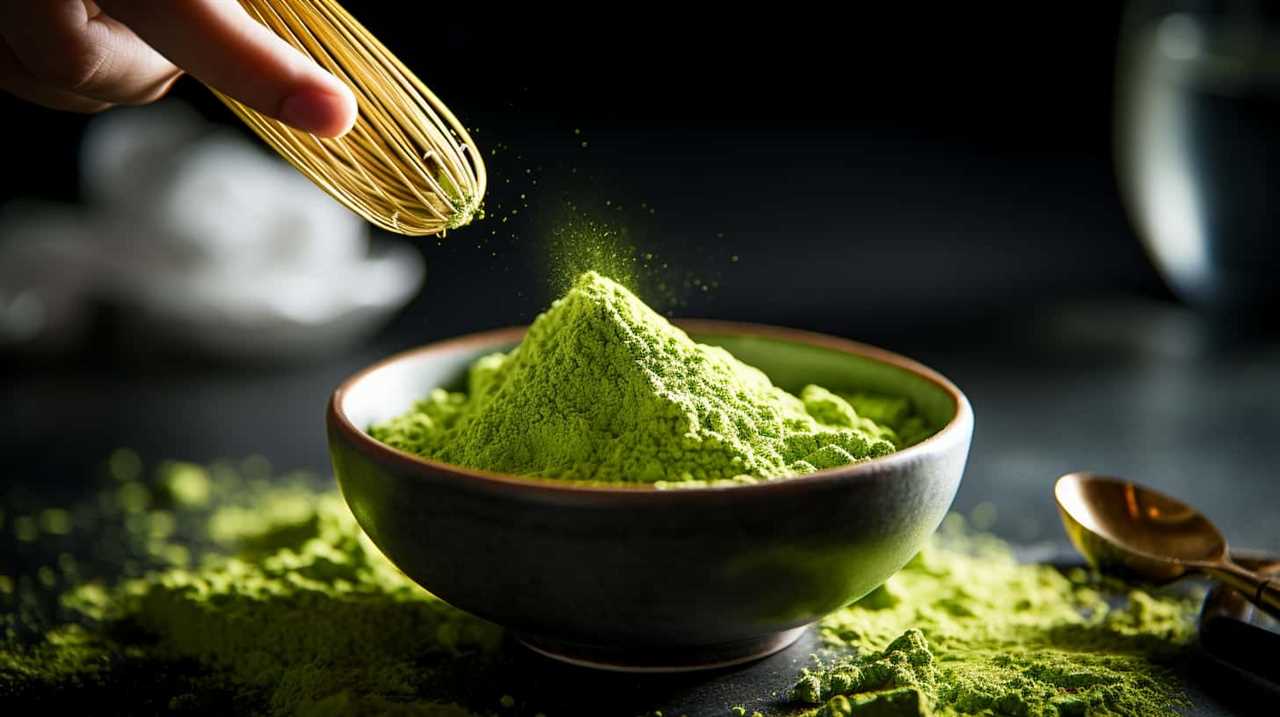
Understanding the Taste of Grass
To truly grasp the taste of grass in matcha, we must appreciate the distinct freshness and subtle sweetness that characterizes this vibrant powdered tea. Matcha, made from finely ground green tea leaves, possesses a unique flavor profile that can be attributed to the presence of grassy notes. The science behind grass flavors lies in the presence of certain compounds, such as chlorophyll and terpenes, which lend a vegetal taste to matcha. These compounds are responsible for the earthy, grassy aroma that wafts from a freshly whisked bowl of matcha.
Beyond its scientific explanation, the cultural significance of grass flavors in matcha can’t be understated. For centuries, Japanese tea ceremonies have celebrated the natural flavors of matcha, highlighting the connection between the tea and the earth. Understanding the taste of grass in matcha allows us to fully appreciate the depth and complexity of this revered beverage.
Ways to Enjoy and Appreciate the Taste of Grass in Matcha:
- Experiment with different matcha grades to experience varying levels of grassiness
- Savor the subtle sweetness that balances the grassy notes, creating a harmonious flavor profile
The Role of Chlorophyll in Matcha Flavor
Continuing our exploration of the taste of grass in matcha, let’s delve into the role of chlorophyll in shaping the flavor of this vibrant powdered tea.
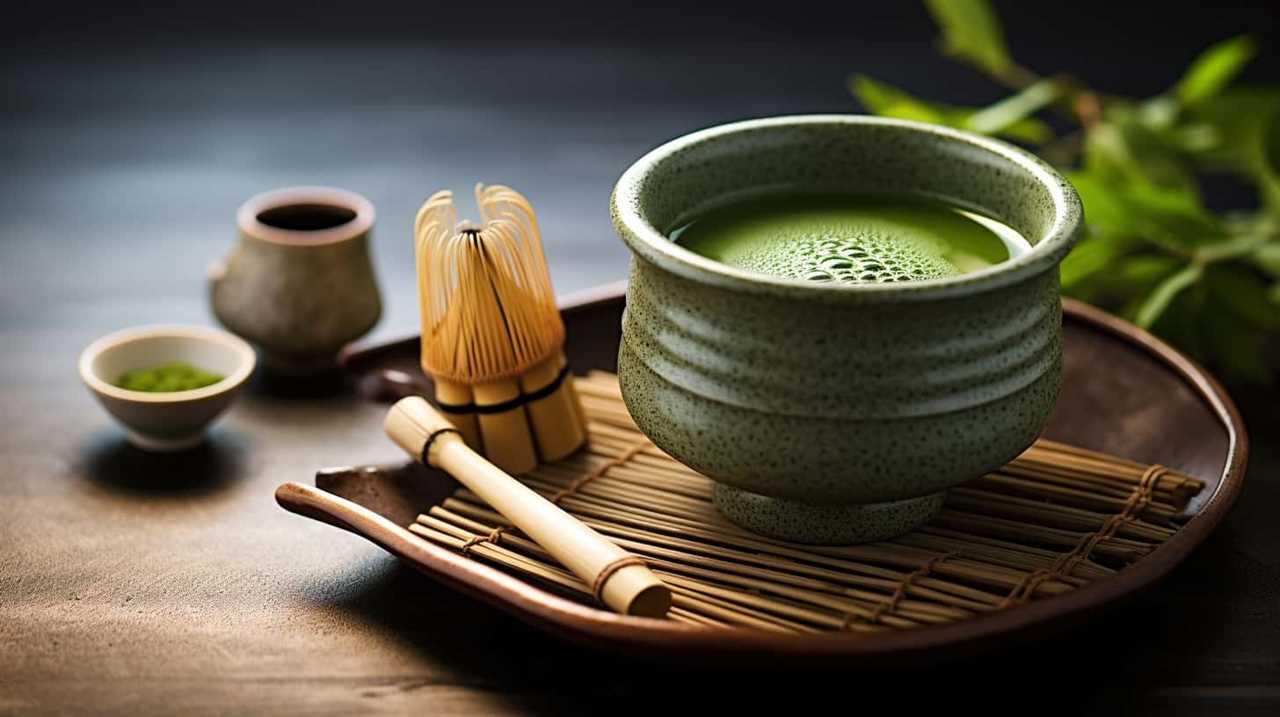
Chlorophyll, the pigment responsible for the green color in plants, plays a significant role in matcha’s grassy flavor. This natural compound is abundant in matcha, as it’s carefully cultivated and shade-grown to enhance its chlorophyll content.
The benefits of chlorophyll in matcha go beyond its contribution to the tea’s flavor. It’s known for its antioxidant properties, which help promote overall health and well-being. Additionally, chlorophyll aids in detoxification and acts as a natural breath freshener.
The science behind matcha’s grassy flavor lies in the presence of chlorophyll, offering a unique and refreshing taste that’s highly sought after by tea enthusiasts.
Matcha: A Taste of Nature
With its abundant chlorophyll content, matcha offers us a truly immersive taste of nature. As we savor its vibrant green hue and earthy flavor, we can also appreciate the health benefits matcha brings.

Let’s delve into the wonders of matcha, exploring its connection to nature and our well-being.
- Matcha in skincare products:
- Matcha’s antioxidants rejuvenate and protect the skin, promoting a youthful glow.
- Its anti-inflammatory properties help soothe and calm irritated skin, reducing redness and blemishes.
- The health benefits of matcha:
- Matcha is rich in catechins, which are potent antioxidants that boost our immune system and fight against free radicals.
- It contains L-theanine, an amino acid that promotes relaxation and mental clarity, enhancing focus and concentration.
As we immerse ourselves in the natural essence of matcha, let’s now explore its umami flavor, a taste sensation that sets matcha apart.
Exploring Umami in Matcha
As we delve into the wonders of matcha and its connection to nature and our well-being, it’s fascinating to explore the umami flavor that sets matcha apart.
Umami is a Japanese word that translates to ‘pleasant savory taste,’ and it’s one of the five basic tastes, along with sweet, sour, bitter, and salty.

Matcha, with its rich and complex flavor profile, contains a notable umami taste that adds depth and complexity to every sip. This unique characteristic is due to the high levels of amino acids, specifically L-theanine, found in matcha.
The umami flavor in matcha not only enhances the taste experience, but it also contributes to the numerous health benefits of matcha, including increased focus, relaxation, and improved overall well-being.
The Influence of Terroir on Matcha Taste
To understand the influence of terroir on matcha taste, we can observe the distinct flavors that different regions produce. Terroir’s impact on matcha flavor variations is remarkable, as the soil, climate, and cultivation techniques all contribute to the final taste profile.
Here are two sub-lists to help you appreciate the nuances:
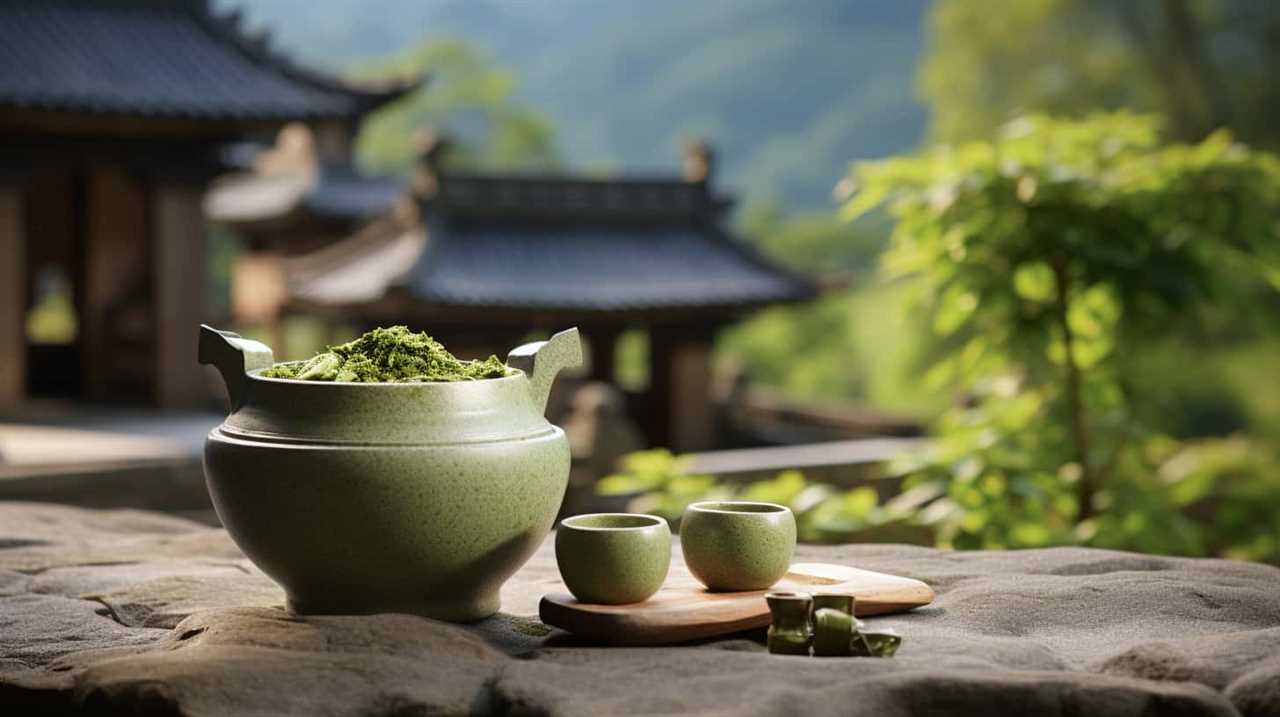
1. Soil composition:
- Matcha from Uji, Japan: Known for its rich, fertile soil, Uji matcha boasts a deep, umami flavor with hints of sweetness.
- Matcha from Nishio, Japan: Nishio’s volcanic soil adds a unique earthiness to its matcha, resulting in a bold and robust flavor.
2. Climate conditions:
- Matcha from Nara, Japan: Nara’s cooler climate slows down the growth of tea leaves, leading to a matcha that’s light, delicate, and subtly sweet.
- Matcha from Kagoshima, Japan: Kagoshima’s warmer climate produces matcha with a vibrant and grassy flavor, offering a refreshing and energizing experience.
Exploring these flavor variations allows matcha enthusiasts to appreciate the diversity and complexity that terroir brings to this beloved beverage.
The Difference Between Ceremonial and Culinary Grade Matcha
Let’s delve into the nuances of ceremonial and culinary grade matcha, exploring their differences in taste and quality. Understanding matcha grades is crucial for those seeking to fully appreciate this vibrant green tea powder.
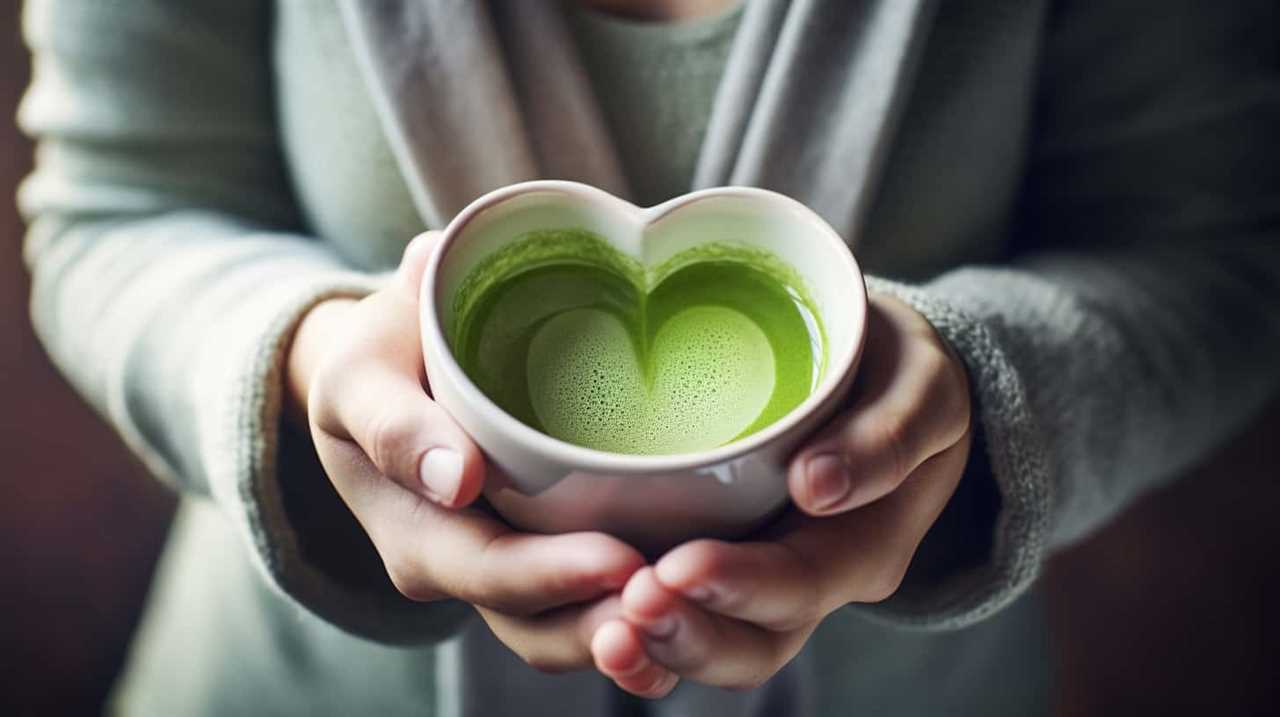
Ceremonial grade matcha is made from the youngest and most tender tea leaves, resulting in a smooth and delicate flavor profile. Its vibrant green color and subtle sweetness make it perfect for traditional tea ceremonies.
On the other hand, culinary grade matcha is made from slightly older leaves and has a stronger, more robust flavor. While it may not have the same level of refinement as ceremonial grade, it’s ideal for baking, cooking, and adding a vibrant green hue to various dishes.
Both grades offer the health benefits of matcha, including high levels of antioxidants, a natural energy boost, and improved focus and concentration.
Brewing Techniques to Enhance Matcha Flavor
To enhance the flavor of matcha, we can use specific brewing techniques. Here are some tips to help you enjoy a more flavorful matcha experience:
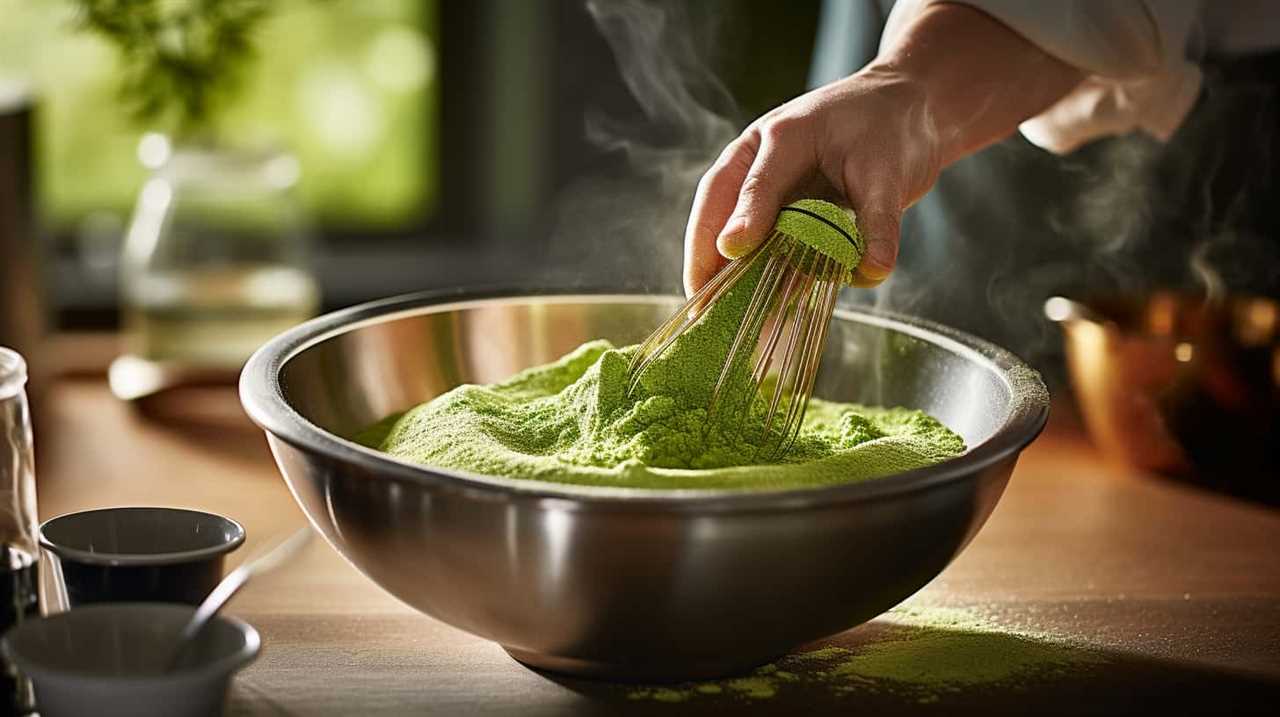
- Exploring Matcha’s Health Benefits:
- Matcha is packed with antioxidants, which can help boost your immune system and promote overall well-being.
- It’s also known to provide a natural energy boost without the jitters or crash associated with coffee.
- The Impact of Different Water Temperatures on Matcha Flavor:
- Water temperature plays a crucial role in bringing out the best flavors in matcha.
- For a smooth and mellow taste, use water that’s around 175°F (80°C). This temperature preserves the delicate flavors of matcha.
- If you prefer a stronger and more robust flavor, try using water that’s slightly hotter, around 185°F (85°C).
Pairing Matcha With Other Flavors
By exploring matcha’s health benefits and experimenting with different water temperatures, we can further enhance the flavor profile of matcha by pairing it with complementary flavors. One of the best ways to elevate the taste of matcha is by exploring unique flavor combinations. One such combination is enhancing matcha with citrus notes. The bright and tangy flavors of citrus fruits like lemon or orange can add a refreshing twist to the earthy taste of matcha. The acidity of these citrus fruits helps to balance the bitterness of matcha, resulting in a harmonious blend of flavors. To give you some inspiration, here is a table showcasing three delicious matcha and citrus combinations:
| Matcha Flavor | Citrus Flavor | Description |
|---|---|---|
| Matcha with Lemon | The zesty notes of lemon bring a burst of freshness to the rich flavor of matcha. | Perfect for a revitalizing morning pick-me-up. |
| Matcha with Orange | The sweet and tangy taste of orange complements the earthiness of matcha, creating a delightful combination. | A great choice for an afternoon treat. |
| Matcha with Grapefruit | The unique tartness of grapefruit adds a surprising twist to the smoothness of matcha. | A refreshing option for hot summer days. |
Experimenting with these flavor combinations will take your matcha experience to a whole new level. So why not give it a try and discover your own favorite matcha and citrus pairing?
Overcoming the Grassiness: Tips for Enjoying Matcha
To enhance the flavor of matcha and overcome its grassy taste, we can employ techniques and strategies that allow us to fully enjoy this unique beverage. Here are some tips to help you savor matcha without being overwhelmed by its grassiness:
- Explore umami: Matcha contains a rich umami flavor that can balance out its grassy notes. To enhance this savory taste, consider adding a pinch of salt or a sprinkle of seaweed flakes to your matcha. These ingredients will heighten the umami profile and create a more well-rounded flavor experience.
- Pairing flavors: Another way to counterbalance the grassy taste of matcha is by pairing it with complementary flavors. For example, you can try adding a touch of sweetness with honey or agave nectar. The natural sweetness will help to mellow out the grassy undertones and create a harmonious blend of flavors.
By exploring umami and experimenting with flavor pairings, you can transform your matcha experience from grassy to delightful.
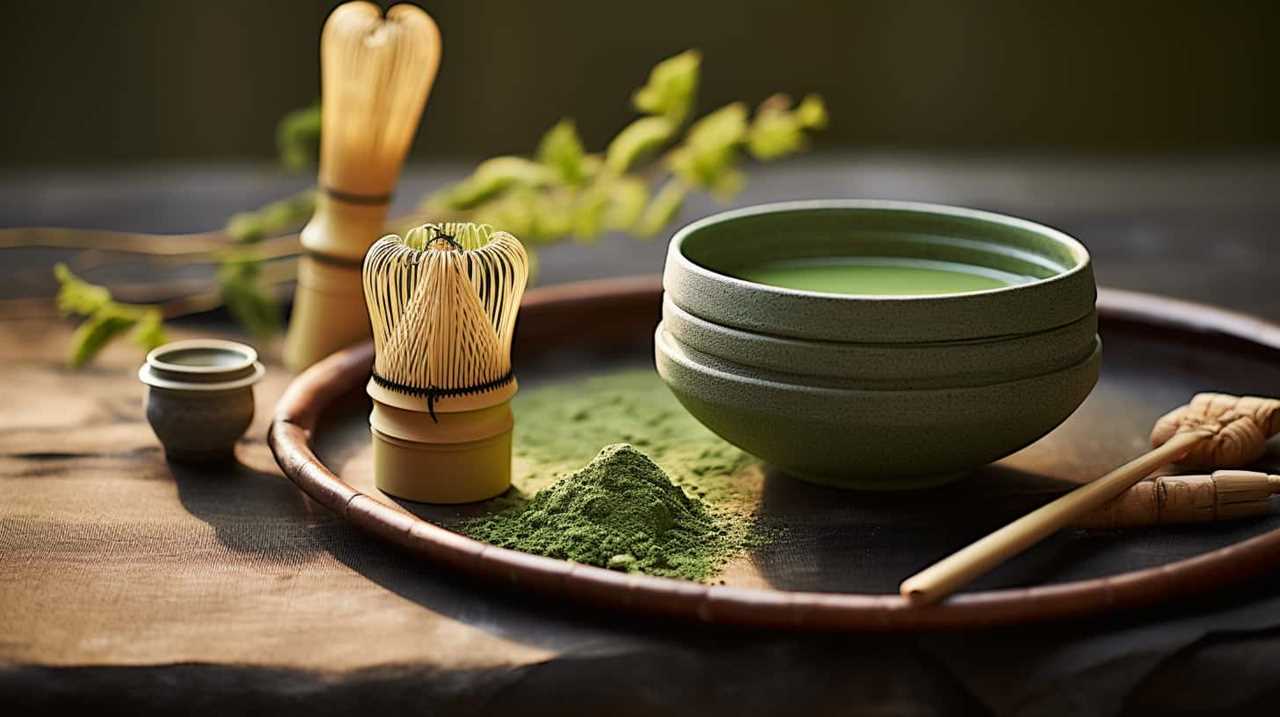
Now, let’s delve into how matcha is used in traditional Japanese cuisine.
Matcha in Traditional Japanese Cuisine
When it comes to traditional Japanese cuisine, matcha has found its place in various dishes. From sushi to desserts like matcha ice cream, matcha adds a unique flavor and vibrant green color to these dishes.
The earthy and slightly bitter taste of matcha complements the delicate flavors of sushi, while the creamy and smooth texture of matcha ice cream provides a refreshing and indulgent treat.
Matcha in Sushi
We have discovered that matcha is commonly used in sushi and other traditional Japanese cuisine. Matcha, with its vibrant green color and distinct flavor, adds a unique twist to these dishes.
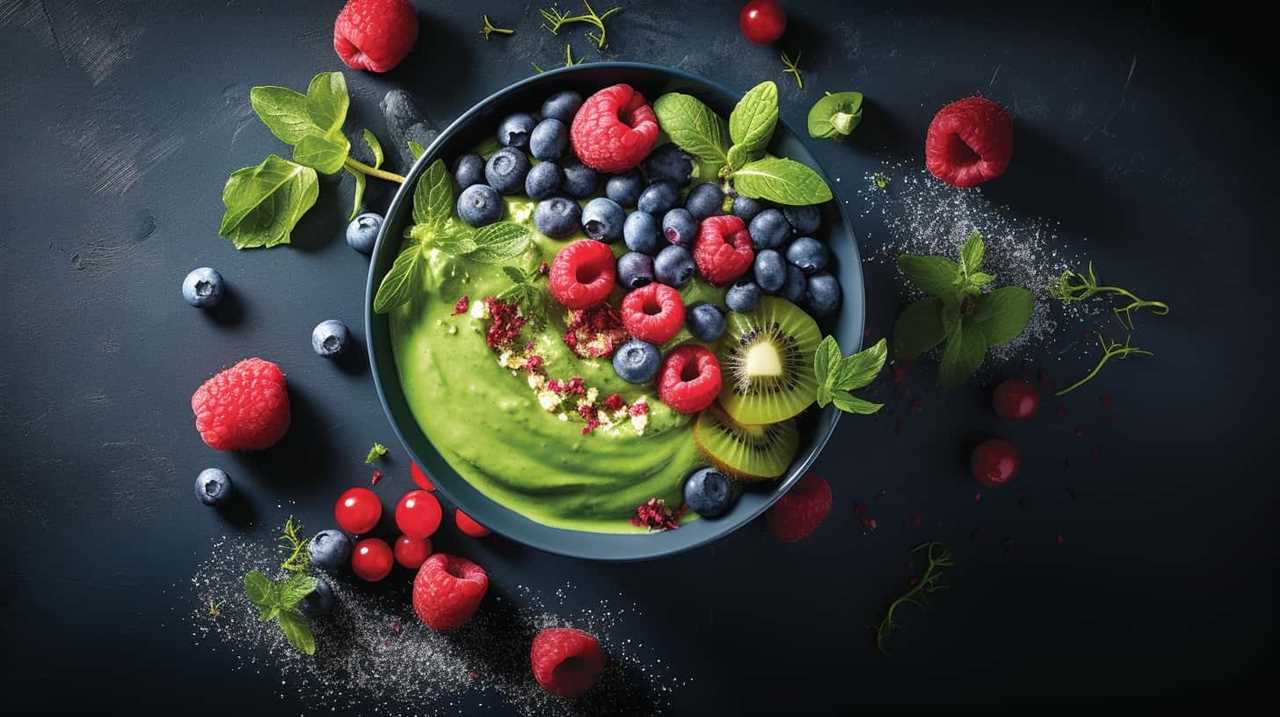
Here are some ways matcha is incorporated in sushi and other traditional Japanese cuisine:
- Matcha in sushi:
- Matcha rice: Sushi rice infused with matcha powder, giving it a subtle green hue and a hint of earthiness.
- Matcha soy sauce: A drizzle of matcha-infused soy sauce adds depth and complexity to the flavors of sushi rolls.
- Matcha in other traditional Japanese cuisine:
- Matcha soba noodles: The earthy notes of matcha complement the nutty flavors of soba noodles.
- Matcha tempura: Tempura battered in a matcha-infused batter, resulting in a crispy outer layer with a unique flavor profile.
These matcha-infused dishes offer a delightful balance of flavors and textures, showcasing the versatility of matcha in Japanese cuisine.
Now, let’s explore another delicious way matcha is enjoyed: matcha ice cream.
Matcha Ice Cream?
There is something about matcha ice cream that we can’t resist. Originating in Japan, matcha ice cream has become a popular treat around the world. The unique flavor of matcha, with its earthy and slightly bitter notes, pairs perfectly with the creamy sweetness of ice cream.
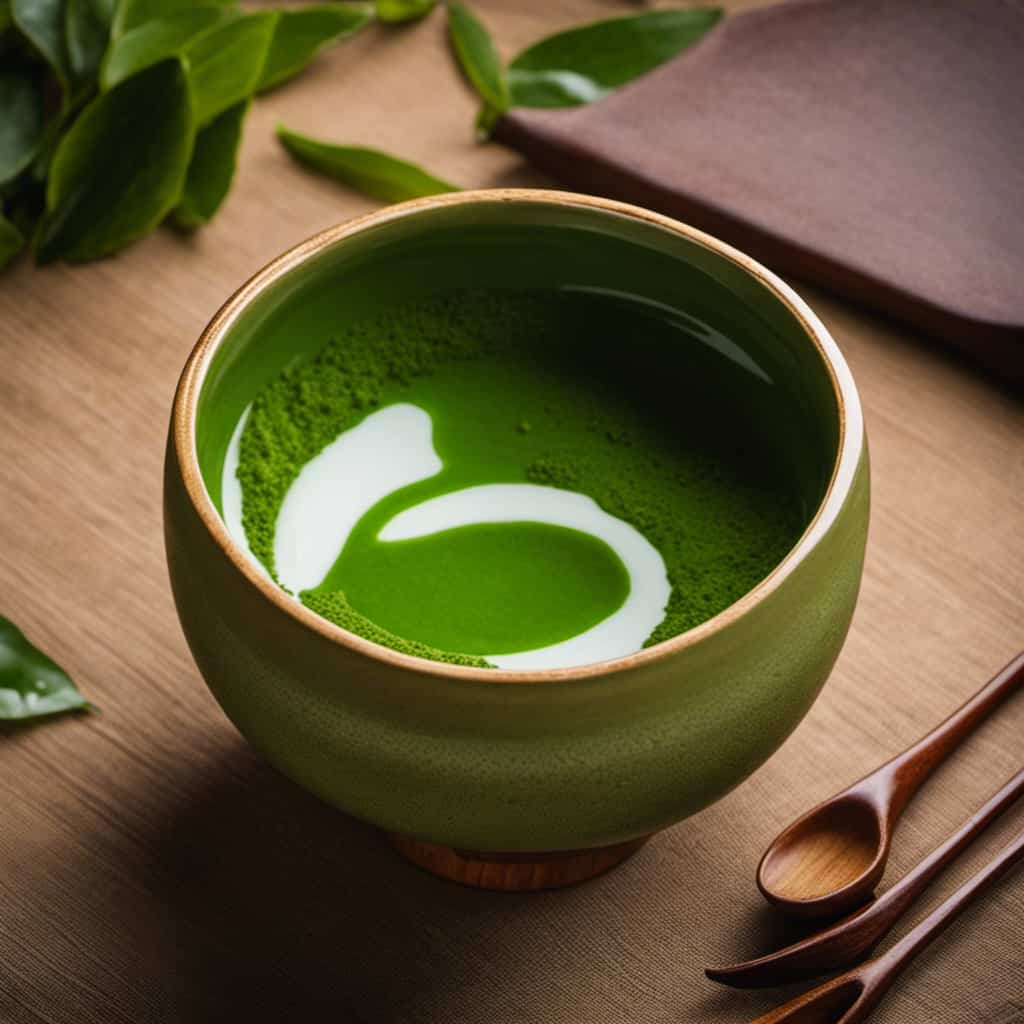
In traditional Japanese cuisine, matcha is often used in desserts to add depth and complexity. Matcha ice cream is made by combining high-quality matcha powder with milk, cream, and sugar, creating a smooth and velvety texture. The result is a refreshing treat that’s both indulgent and satisfying.
What sets matcha ice cream apart is its versatility. It can be enjoyed on its own, or paired with other flavors for a delightful combination. Some unique matcha flavor combinations include matcha and black sesame, matcha and red bean, or even matcha and white chocolate.
Whether enjoyed in a traditional Japanese tea ceremony or scooped into a cone on a hot summer day, matcha ice cream is a delicious way to experience the rich and distinctive flavors of matcha.
The Growing Popularity of Matcha-Infused Treats
The increasing demand for matcha-infused treats has led to a surge in their availability and variety. Matcha, a finely ground powder made from green tea leaves, has become a popular ingredient in desserts and snacks, offering a unique and distinct flavor profile.
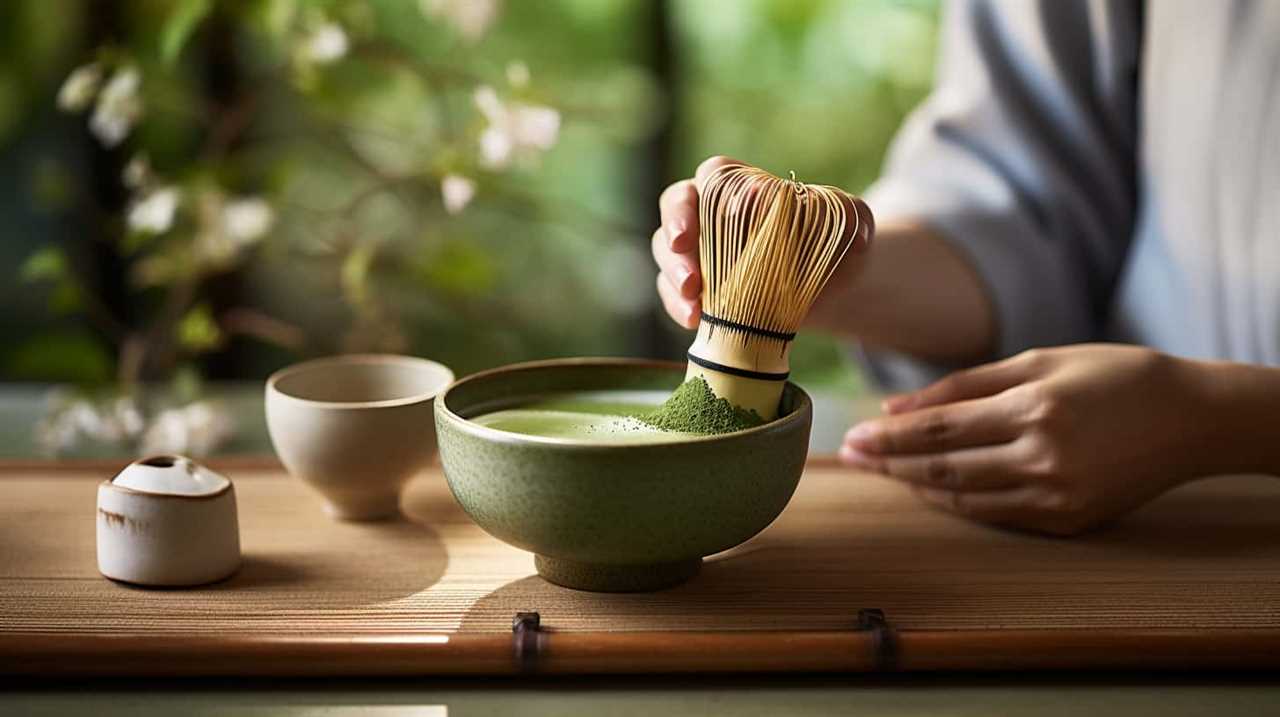
Here are some reasons why matcha-infused treats are gaining popularity:
- Exploring matcha-infused beverages:
- Matcha lattes: A creamy and frothy combination of matcha and milk, offering a smooth and balanced taste.
- Matcha smoothies: Blending matcha with fruits and yogurt creates a refreshing and energizing drink.
- Matcha’s presence in the beauty industry:
- Matcha face masks: Packed with antioxidants, matcha is believed to nourish and rejuvenate the skin, providing a healthy and radiant complexion.
- Matcha bath bombs: Infused with matcha powder, these bath bombs are said to detoxify and soothe the skin, leaving it feeling soft and refreshed.
With its growing popularity, matcha-infused treats offer a delightful and unique experience, both in taste and in the potential benefits they provide.
Personal Experiences With Matcha Flavor Profile
When it comes to matcha, the flavor can be quite unexpected. Some people love the taste, finding it earthy and refreshing, while others hate it, describing it as tasting like grass.
Personally, I enjoy matcha in desserts, like matcha ice cream or matcha-flavored pastries, as it adds a unique and subtle bitterness that balances the sweetness.

Unexpected Matcha Flavors
We have encountered a myriad of unexpected flavors while exploring the matcha flavor profile. Matcha, known for its earthy and grassy taste, has surprisingly found its way into various culinary creations. Here are some of the unexpected matcha flavors we’ve discovered:
- Exploring Matcha Cocktails
- Matcha Mojito: A refreshing twist on a classic cocktail, the matcha adds a unique herbal note that pairs perfectly with the mint and lime.
- Matcha Martini: This elegant cocktail combines the smoothness of vodka with the subtle bitterness of matcha, resulting in a sophisticated and vibrant drink.
- Matcha in Savory Dishes
- Matcha Pasta: The vibrant green hue of matcha pasta adds a visual appeal to any dish. Its slightly bitter taste complements creamy sauces and seafood beautifully.
- Matcha Ramen: By infusing matcha into the broth, it adds a delicate flavor and a touch of umami to the traditional ramen, creating a truly unforgettable dining experience.
These unexpected matcha flavors showcase the versatility of this unique ingredient, elevating both cocktails and savory dishes to new heights of culinary mastery.
Love or Hate
Exploring the unexpected matcha flavors has allowed us to form personal opinions on whether we love or hate the distinct grassy taste. Some individuals may find themselves falling head over heels for the unique flavor profile of matcha, while others may remain indifferent or even detest it.
The love vs. indifference towards matcha flavor can be attributed to various factors, including individual preferences and cultural backgrounds. While some may appreciate the earthy and vegetal notes of matcha, others may find it overwhelming or unpleasant.
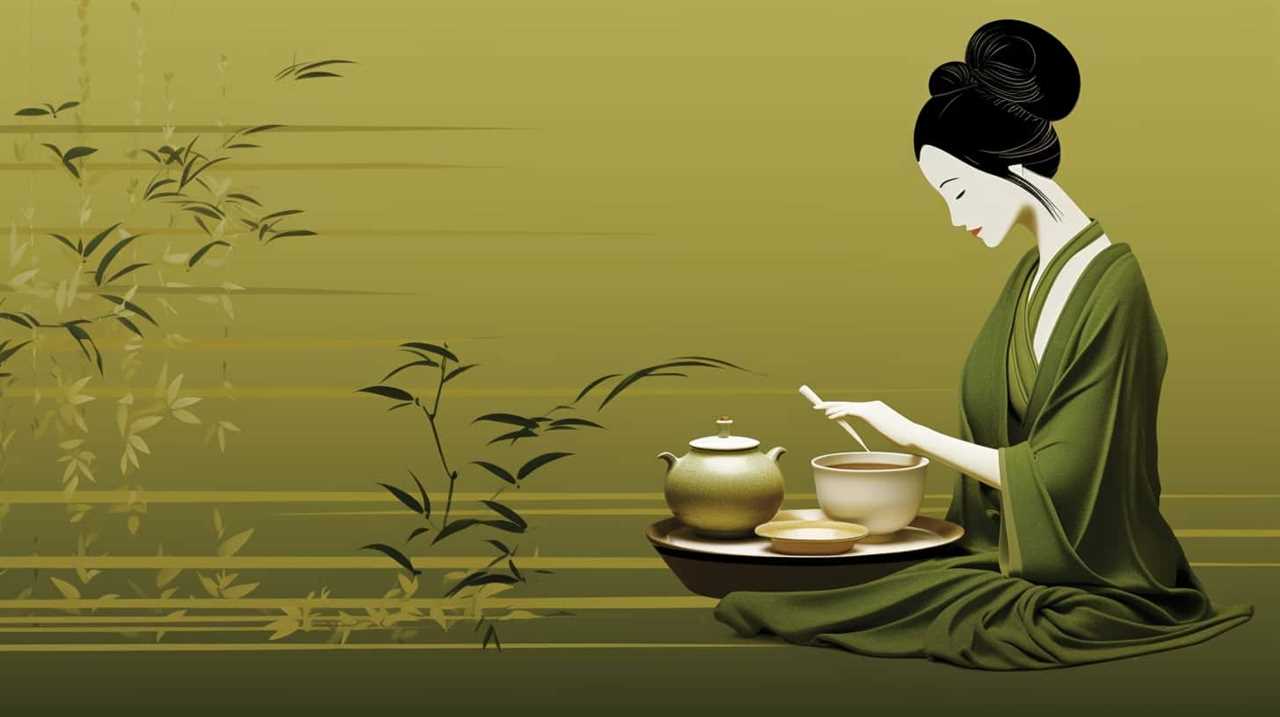
However, it’s important to note that matcha not only offers a distinct flavor experience but also boasts numerous health benefits. From its high antioxidant content to its potential role in boosting metabolism and promoting relaxation, matcha has become a popular choice for those seeking both flavor and wellness in their daily routine.
Matcha in Desserts
As we delved into the world of matcha flavors, our personal experiences with the distinct grassy taste extended to the realm of desserts. Matcha, with its vibrant green color and earthy flavor, has found its way into a wide array of indulgent treats. Here are some of our favorite ways to enjoy matcha in desserts:
- Matcha Infused Beverages:
- Matcha Latte: A creamy and frothy concoction made with matcha powder, steamed milk, and a touch of sweetness.
- Matcha Smoothie: A refreshing blend of matcha, fruits, and yogurt for a healthy and energizing treat.
- The Health Benefits of Matcha Desserts:
- Antioxidant Powerhouse: Matcha is packed with antioxidants that help boost the immune system and fight against free radicals.
- Calming Effects: Matcha contains the amino acid L-theanine, which promotes relaxation and mental clarity.
Indulging in matcha-infused desserts not only satisfies your sweet tooth but also provides a range of health benefits. So go ahead and treat yourself to a delicious matcha creation!
Frequently Asked Questions
Is Matcha Always Supposed to Taste Like Grass?
Matcha flavor preferences vary among individuals. While some people may describe it as tasting like grass, others appreciate its unique flavor profile. It is important to explore different matcha grades and preparation methods to find the taste that suits your palate.
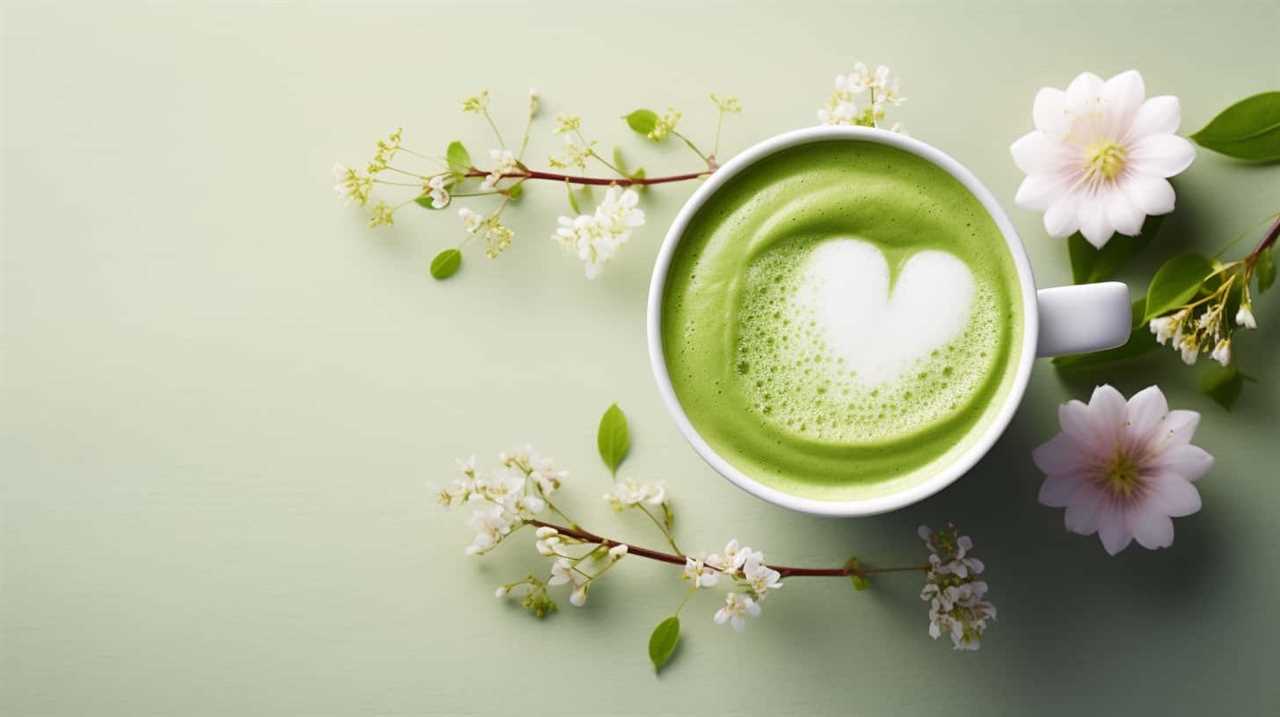
How Does the Taste of Matcha Compare to Other Types of Tea?
Comparing matcha to other teas reveals a nuanced flavor spectrum. Unlike grassy matcha, black tea possesses a bold richness, while green tea offers a delicate freshness. Matcha’s unique umami notes make it a versatile ingredient in desserts.
Can Matcha Taste Different Depending on Where It Is Grown?
Different flavor profiles and regional variations can definitely affect the taste of matcha. Factors like climate, soil, and cultivation methods influence the flavor and aroma, resulting in unique and distinct matcha varieties from different regions.
Are There Any Specific Foods or Flavors That Pair Well With Matcha?
When it comes to matcha, there are plenty of flavorful combinations to explore. From decadent matcha dessert recipes to unique flavor pairings like matcha and citrus, the possibilities are endless. Discover the world of matcha delights!
Are There Any Techniques to Reduce the Grassy Taste of Matcha?
Reducing the grassy taste in matcha and enhancing its flavor can be achieved through various techniques. By adjusting water temperature, whisking method, and using higher quality matcha, the undesirable grassy notes can be minimized, resulting in a more enjoyable and flavorful matcha experience.

Conclusion
In conclusion, matcha’s distinctive grassy taste is a testament to its origins in nature. The hint of umami adds depth to this unique flavor profile.
While some may find the grassiness off-putting, there are ways to overcome it and truly enjoy the experience of matcha.
As the popularity of matcha continues to grow, it’s clear that this vibrant green tea has found its place not only in traditional Japanese cuisine but also in modern treats and beverages.
As the saying goes, ‘Taste the grass, savor the earth.’
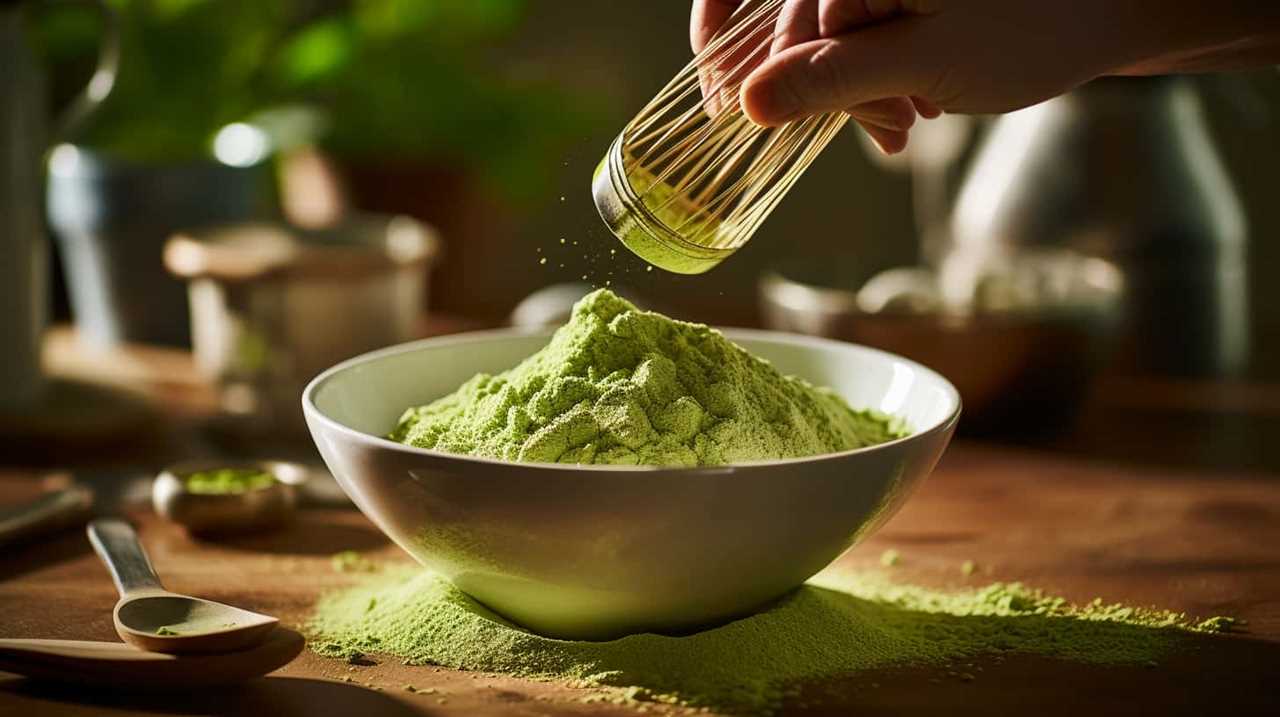
Justin is a seasoned author, coffee and tea enthusiast, and an essential member of the Cappuccino Oracle team. With a keen appreciation for the complexities of coffee, coffee alternatives, and tea, Justin has dedicated his professional career to exploring these realms and sharing his insights with readers worldwide.
Justin’s immersion in the world of coffee, coffee alternatives, and tea began at a young age, kindling a passion that extended beyond mere consumption. This love for these beverages led him to combine his talent for writing with his devotion to coffee and tea, bringing him to Cappuccino Oracle as a dedicated author.
Matcha
Unveiling The Mysteries Of Matcha: Insights On Its Origins, Production, And Quality

Have you ever been curious about the mysteries behind the rich and natural flavors of matcha? If so, get ready to join me on an adventure as we uncover the secrets of matcha, delving into its origins, production, and quality.
As a lover of all things tea, I have delved deep into the world of matcha, immersing myself in its rich history and intricate production process. From the shade-grown tea leaves to the meticulous grinding technique, every step is a labor of love that culminates in the velvety smooth powder we know as matcha.
Join me as we unravel the secrets behind this ancient Japanese tradition and discover why quality is key when indulging in this verdant elixir. We’ll explore the nuances of flavor, the importance of sourcing, and even delve into the fascinating world of other tea varieties.
So grab a cup, sit back, and let’s dive into the captivating world of matcha.
Key Takeaways
- Matcha tea is made from powdered green tea leaves and has a long and labor-intensive production process.
- Premium matcha is made from the first harvest in early spring, using the top 3 sprouts of the tea plant and ground tencha leaves.
- Cheaper matchas may skip some steps in the production process and are more suitable for matcha lattes.
- High-quality matcha is recommended for sparing consumption, as it has a smoother flavor and more health benefits compared to cheaper matchas.
What is matcha?
I’ve learned that matcha is a powdered green tea made from special tea leaves that are shaded before harvest, and it has a long and labor-intensive production process.
There are different types of matcha available, but the premium matcha is made from the first harvest in early spring, using only the top 3 sprouts of the tea plant. The leaves are then steamed, dried, and have their stems removed before being ground into a fine powder using a specialized mill made of granite.
It’s important to note that high-quality matcha is recommended for sparing consumption, as it has a complex production process that results in a smooth flavor. Matcha also offers various health benefits, such as being rich in antioxidants, boosting metabolism, and improving mental alertness.
Production process
The matcha production process involves shading the tea leaves before harvest and selecting the top three sprouts of the tea plant for premium matcha. Shading is a technique used to enhance the flavor and quality of the tea leaves. By covering the tea plants with shade, the leaves produce more chlorophyll and amino acids, resulting in a vibrant green color and a rich, umami taste.
After the shading period, only the top three sprouts of the tea plant are carefully handpicked for premium matcha. These selected leaves, known as tencha leaves, are then steamed, dried, and have their stems removed.
Finally, the tencha leaves are ground into a fine powder using a specialized granite mill. This process results in the smooth and concentrated matcha powder that we enjoy.
Quality and consumption
Let me tell you, indulging in high-quality matcha is like sipping a vibrant green elixir that awakens your taste buds and nourishes your body with its rich flavor and numerous health benefits. Matcha’s health benefits are truly remarkable. Packed with antioxidants, vitamins, and minerals, matcha is known to boost metabolism, enhance focus and concentration, and strengthen the immune system.
But not all matcha is created equal. Different grades of matcha exist, ranging from ceremonial grade to culinary grade. Ceremonial grade matcha is made from the highest quality tencha leaves and has a smooth, vibrant green color and a delicate, umami flavor. It is best enjoyed on its own, whisked with hot water.
On the other hand, culinary grade matcha is more affordable and is suitable for making matcha lattes, smoothies, and baked goods. Although it may have a slightly bitter taste and a duller color, it still provides health benefits.
So, whether you choose to indulge in high-quality ceremonial grade matcha or opt for the more affordable culinary grade, incorporating matcha into your routine is a delicious way to reap its health benefits.
Frequently Asked Questions
What are some popular ways to enjoy matcha besides drinking it as tea?
Besides drinking matcha as tea, some popular ways to enjoy it include indulging in matcha desserts like matcha ice cream, matcha cake, and matcha cookies. Additionally, matcha smoothies are a refreshing and healthy option.
Are there any specific health benefits associated with consuming matcha?
I’m no expert, but matcha is said to have potential health benefits. Some claim it can aid in weight loss due to its high antioxidant content and metabolism-boosting properties. However, more research is needed to confirm these claims.
How does the quality of matcha affect its flavor and overall experience?
The quality of matcha directly affects its flavor and overall experience. Higher quality matcha, made from carefully selected leaves and processed with precision, offers a smoother and more vibrant flavor, while lower quality matcha may have a less appealing taste and color.
Can matcha be used in cooking or baking?
"Where there’s matcha, there’s a way! Matcha can be used in a variety of cooking and baking recipes, adding a vibrant green color and a unique earthy flavor to dishes like matcha desserts."
Are there any specific tips or techniques for properly preparing matcha tea at home?
To properly prepare matcha tea at home, start by sifting the matcha powder to remove any clumps. Then, choose water at around 175°F to 180°F for the best flavor. Gradually add water to the matcha and whisk in a "W" or "M" motion until frothy. Enjoy!
Conclusion
In conclusion, matcha tea is not just a beverage, but a rich and fascinating tradition that has evolved over centuries.
From its origins in Japan to its intricate production process, matcha is a labor of love.
The quality of matcha is crucial, as the steps taken in its production directly impact its flavor and aroma.
Whether you’re a matcha connoisseur or a beginner, there is a matcha tea out there for you.
So, why not indulge in a cup of this vibrant green elixir and experience the magic of matcha for yourself? It’s a journey worth embarking on!
Arf, an author and an innovative enthusiast of coffee, coffee alternatives, and tea, plays a crucial role as a contributor to the esteemed Cappuccino Oracle platform. Renowned for his curiosity and passion for these captivating beverages, Arf has carved out a unique space for himself in the world of exploration and writing. He realized that coffee, coffee alternatives, and tea are not mere drinks to keep one awake, but universes of flavors and stories waiting to be explored.
Arf’s articles for Cappuccino Oracle blend meticulous research with personal experiences, providing readers with an in-depth understanding of various types of coffee, coffee alternatives, and tea, along with their unique characteristics, cultures, and histories. His honest reviews and engaging narratives guide readers on their own journeys, helping them discover their preferences and find their perfect brew.
Matcha
Unveiling The Truth Behind Starbucks’ Matcha: A Disappointing Blend

Being a lover of tea, I was eager to sample Starbucks’ matcha beverages, anticipating a flavorful and genuine taste. However, to my dismay, I found that it was a subpar mixture of inexpensive green tea powder and an excessive amount of sugar. This was a stark contrast to the customary matcha experience that I had grown accustomed to.
The use of low-quality matcha by Starbucks is driven by the need for mass production and a consistent taste across all locations. But in this pursuit, they have sacrificed the true essence of matcha. Authentic matcha production involves meticulous steps to ensure a high-quality and flavorful product, steps that Starbucks seems to skip.
The result is a matcha latte packed with 32 grams of sugar, equivalent to a can of soda, and a whopping 240 calories. It’s time to unveil the truth behind Starbucks’ matcha and explore better options for a truly satisfying tea experience.
Key Takeaways
- Starbucks uses a cheap green tea powder for their matcha drinks, which may not even be considered matcha.
- The cheap matcha powder is mixed with a lot of sugar, negating the health benefits and undermining the quality of the tea.
- Starbucks’ matcha latte contains a high amount of sugar, similar to a can of soda, and has a significant number of calories.
- To have a better matcha experience, it is recommended to explore premium, first harvest matcha made by talented farmers in Japan and to try different matcha options to find preferred taste.
What is Starbucks Matcha?
Starbucks Matcha is a cheap green tea powder mixed with a high amount of sugar, which not only undermines the health benefits of matcha but also fails to deliver the natural, great-tasting flavor of authentic matcha tea.
The ingredients used in Starbucks matcha include low-quality green tea powder that is likely produced on a large scale. Unlike traditional matcha production methods, Starbucks skips certain steps to save time and money. These steps, such as shading the tea plants to reduce bitterness and selecting the top leaves for their flavor and nutrients, are crucial in creating high-quality matcha.
Instead, Starbucks opts for a blend of cheap green tea powder mixed with sugar, resulting in a dull and bitter flavor. This disappointing blend of ingredients does not live up to the standards of true matcha tea.
Quality vs. Cheap Matcha
Indulging in high-quality matcha is like savoring a delicate melody that dances on your taste buds, while settling for cheap matcha is akin to a discordant symphony that leaves a bitter aftertaste. When it comes to matcha, quality matters. Traditional matcha production is an art that requires time, patience, and attention to detail. The importance of shading the tea plants, selecting the top leaves, and using a stone mill to grind the leaves into a fine powder cannot be overstated. These steps not only enhance the flavor but also preserve the health benefits of matcha. High-quality matcha is rich in antioxidants, boosts metabolism, and promotes a sense of calm. On the other hand, cheap matcha often lacks these qualities as it skips crucial steps and is mixed with sugar and other additives. Don’t settle for a subpar matcha experience; choose high-quality matcha for its exceptional taste and health benefits.
| Traditional Matcha Production |
|---|
| Shading the tea plants |
| Selecting the top leaves |
| Grinding with a stone mill |
The importance of traditional matcha production cannot be overstated. These steps not only enhance the flavor but also preserve the health benefits of matcha. High-quality matcha is rich in antioxidants, boosts metabolism, and promotes a sense of calm. On the other hand, cheap matcha often lacks these qualities as it skips crucial steps and is mixed with sugar and other additives. Don’t settle for a subpar matcha experience; choose high-quality matcha for its exceptional taste and health benefits.
Recommendations for Better Matcha
Exploring different matcha options can lead to a better matcha experience. When it comes to matcha, not all options are created equal. While Starbucks may offer a convenient matcha latte, there are alternative options that provide a more authentic and higher quality experience.
Premium matcha, specifically first harvest matcha, is made by talented farmers in Japan and can be enjoyed plain, without the need for excessive sugar or additives. By choosing premium matcha, you can reap the full benefits that matcha has to offer, such as its high antioxidant content and potential health benefits.
Additionally, exploring different types of matcha, such as Japanese black tea, can expand your taste palate and introduce you to new and exciting flavors. So, why settle for a disappointing blend when there are better matcha options out there waiting to be explored?
Frequently Asked Questions
How is Starbucks matcha different from traditional matcha?
Starbucks matcha differs from traditional matcha in terms of quality and taste. One interesting statistic is that Starbucks’ matcha latte contains 32 grams of sugar, similar to a can of soda, which undermines the health benefits of matcha.
What are the health benefits of matcha and how do they differ between Starbucks matcha and premium matcha?
The health benefits of matcha include high levels of antioxidants, increased energy, and improved focus. However, Starbucks matcha quality is compromised due to the use of cheap powder mixed with sugar, negating these benefits.
Can you customize the sweetness level of Starbucks matcha drinks?
Yes, you can customize the sweetness level of Starbucks matcha drinks. They offer popular matcha drink variations like matcha latte and matcha frappuccino, allowing customers to choose the amount of sweetener they prefer.
Are there any alternative options for matcha drinks at Starbucks?
Yes, there are alternative options for matcha drinks at Starbucks. However, it’s important to note that the taste may not be comparable to traditional matcha. Exploring different matcha options and Japanese black tea can provide a better experience.
What are the steps involved in producing high-quality matcha and how does Starbucks’ matcha production differ?
Starbucks’ matcha production process differs from traditional matcha production in Japan. High-quality matcha involves shading the tea plants, selecting the top leaves, steaming, drying, and grinding them. However, Starbucks skips these steps, resulting in a lower quality and less authentic matcha experience.
Conclusion
In conclusion, after delving into the truth behind Starbucks’ matcha, it’s clear that their blend falls short of expectations. The use of cheap green tea powder mixed with excessive sugar dilutes any potential health benefits and fails to deliver an authentic matcha experience.
To truly enjoy the rich and flavorful taste of matcha, it’s recommended to explore premium, first harvest options crafted by skilled Japanese farmers. Don’t settle for subpar matcha; treat yourself to a tea experience that’ll leave your taste buds dancing with delight.
Arf, an author and an innovative enthusiast of coffee, coffee alternatives, and tea, plays a crucial role as a contributor to the esteemed Cappuccino Oracle platform. Renowned for his curiosity and passion for these captivating beverages, Arf has carved out a unique space for himself in the world of exploration and writing. He realized that coffee, coffee alternatives, and tea are not mere drinks to keep one awake, but universes of flavors and stories waiting to be explored.
Arf’s articles for Cappuccino Oracle blend meticulous research with personal experiences, providing readers with an in-depth understanding of various types of coffee, coffee alternatives, and tea, along with their unique characteristics, cultures, and histories. His honest reviews and engaging narratives guide readers on their own journeys, helping them discover their preferences and find their perfect brew.
Matcha
The Ultimate Guide To Using Chashaku: Your Matcha Essential

Being a lover of matcha, I am aware that the crucial factor in achieving the perfect matcha bowl is the equipment we utilize. When it comes to preparing matcha, there is one tool that is particularly essential: the chashaku.
This bamboo spoon, with its elegant design and precise measurements, is the secret weapon of matcha lovers worldwide. In this ultimate guide, I will take you on a journey through the history and evolution of the chashaku, and show you how to use it like a pro.
From its origins as a metal or ivory scoop to its modern-day incarnation in bamboo, the chashaku has come a long way. With its 48° bend and 18mm length, it effortlessly scoops the perfect amount of matcha from its container.
So grab your chashaku and get ready to elevate your matcha game to new heights. Let’s dive in and discover the wonders of this matcha essential.
Key Takeaways
- Chashaku is a bamboo spoon used to scoop matcha powder in the Japanese tea ceremony and by matcha lovers worldwide.
- Chashaku is one of the three important tea utensils used in the tea ceremony and is about 18mm in length with a 48° bend at the end for scooping.
- Chashaku is made of bamboo to avoid negative reactions with matcha powder and is a great measurement tool for matcha powder.
- Two scoops of chashaku is the standard amount for a bowl of matcha tea, and it is easy to maneuver in matcha tins or natsume due to its small size.
What is Chashaku?
Chashaku is a bamboo spoon used to scoop matcha powder, and it’s one of the three important tea utensils used in the Japanese tea ceremony.
Made from a single piece of bamboo, this elegant tool has a long history dating back to the Muromachi period in Japan. Originally crafted from metal or ivory, chashaku evolved to be made of bamboo due to its natural properties and to avoid any negative reactions with matcha powder.
The design of chashaku is both functional and beautiful, with a length of about 18mm and a 48° bend at the end for easy scooping. There are different styles of chashaku scoops, each with its own unique shape and characteristics. The back of the chashaku has a rough texture, while the face is smooth and sleek.
Whether you’re a matcha lover or a tea ceremony enthusiast, using a chashaku adds a touch of authenticity and tradition to your matcha preparation.
History and Evolution
During the Muromachi period in Japan, the chashaku spoon evolved from being made of metal or ivory to its current bamboo form, which is about 18mm in length and has a 48° bend at the end for easier scooping. The history and evolution of the chashaku is a testament to its significance in Japanese tea ceremonies and its cultural importance in matcha preparation.
| The significance of chashaku in Japanese tea ceremonies | The cultural importance of chashaku in matcha preparation |
|---|---|
| Chashaku is one of the three important tea utensils used in the tea ceremony. | Chashaku is a great measurement tool for matcha powder. |
| Chashaku originated in Japan during the Muromachi period. | Chashaku’s small size allows for easy maneuvering in matcha tins or natsume. |
| Originally made of metal or ivory, chashaku evolved to be made of bamboo. | Chashaku is made from a single piece of bamboo and shaped with a bend for the scoop. |
| Chashaku is made of bamboo to avoid negative reactions with matcha powder. | The back of chashaku has a rough texture, while the face is smooth and sleek. |
The chashaku’s role in Japanese tea ceremonies cannot be understated. It is one of the three essential utensils used in the tea ceremony, alongside the chawan (tea bowl) and chasen (tea whisk). The chashaku’s small size and precise measurement make it the perfect tool for scooping matcha powder. Its evolution from metal or ivory to bamboo shows the cultural importance placed on this utensil. The chashaku’s design, with its gentle bend and smooth face, allows for easy and graceful scooping of matcha. Using the chashaku is not only practical but also a way to honor the centuries-old tradition of matcha preparation.
How to Use Chashaku
To use the chashaku, I simply hold it like a pencil and dip the scoop into the matcha container. Then, I carefully lift the chashaku scoop out and place it over the matcha bowl to dump the powder.
It’s a simple and elegant technique that ensures the perfect amount of matcha every time.
But did you know that there are alternative ways to use the chashaku? Some matcha lovers prefer to use a teaspoon or a regular spoon to scoop their matcha powder. While these alternatives may work in a pinch, they don’t offer the same precision and authenticity as the chashaku.
The chashaku’s unique design and size make it the ideal tool for measuring matcha powder. Plus, using the chashaku adds a traditional touch to the matcha preparation process, enhancing the overall experience.
So why settle for anything less? Embrace the chashaku and elevate your matcha game to the next level.
Frequently Asked Questions
What are the different types of materials used to make chashaku besides bamboo?
There’s something truly magical about the chashaku, the bamboo spoon that gracefully scoops matcha powder. While bamboo is the traditional material, chashaku can also be made from metal or ivory, although these alternatives are less common.
Can chashaku be used to scoop other powders besides matcha?
Yes, chashaku can be used to scoop other powders besides matcha. However, it is primarily designed for scooping matcha powder and is most commonly used in Japanese tea ceremonies. To properly clean and care for a chashaku, it is recommended to wipe it with a dry towel or tissue to avoid water damage. The chashaku is a versatile tool with different uses in the tea ceremony, making it an essential item for matcha lovers.
How long does a chashaku typically last before it needs to be replaced?
A chashaku typically lasts for a long time, but the lifespan can vary depending on the material. Bamboo chashaku is the most common and durable option, while metal or ivory may wear down over time. Proper care involves cleaning with a dry towel or tissue to avoid water damage.
Can chashaku be used with different types of matcha bowls or is it specific to a certain style?
Absolutely! Chashaku can be used with various types of matcha bowls, adapting to different styles. Its small size and unique design make it perfect for scooping matcha powder and adding a touch of elegance to your matcha preparation.
Are there any alternative utensils that can be used in place of chashaku for scooping matcha powder?
Yes, there are alternative utensils for scooping matcha powder, such as a teaspoon or a small spoon. However, using a chashaku has its benefits. Its unique design allows for precise measurements and easy maneuvering in matcha tins.
Conclusion
In conclusion, using chashaku isn’t just a practical way to measure and scoop matcha powder, but it’s also an essential tool for embracing the art and tradition of the Japanese tea ceremony.
While some may argue that using a regular spoon can achieve the same result, chashaku offers a unique experience that connects us to centuries of tea culture. Imagine holding the slender bamboo spoon, feeling the weight of tradition in your hand, and delicately scooping the vibrant green matcha powder.
It’s a sensory journey that brings us closer to the beauty and mindfulness of matcha preparation. So, embrace the chashaku, and let it elevate your matcha experience to new heights.
Arf, an author and an innovative enthusiast of coffee, coffee alternatives, and tea, plays a crucial role as a contributor to the esteemed Cappuccino Oracle platform. Renowned for his curiosity and passion for these captivating beverages, Arf has carved out a unique space for himself in the world of exploration and writing. He realized that coffee, coffee alternatives, and tea are not mere drinks to keep one awake, but universes of flavors and stories waiting to be explored.
Arf’s articles for Cappuccino Oracle blend meticulous research with personal experiences, providing readers with an in-depth understanding of various types of coffee, coffee alternatives, and tea, along with their unique characteristics, cultures, and histories. His honest reviews and engaging narratives guide readers on their own journeys, helping them discover their preferences and find their perfect brew.
-

 Americano3 weeks ago
Americano3 weeks agoHow to Make Americano With Moka Pot
-

 Americano7 days ago
Americano7 days agoHow to Make Korean Iced Americano
-

 Americano4 weeks ago
Americano4 weeks agoHow to Make an Americano in a French Press
-

 Americano3 weeks ago
Americano3 weeks agoHow to Make Iced Americano With Instant Coffee
-

 Americano4 weeks ago
Americano4 weeks agoWhat to Add to an Americano at Starbucks
-

 Americano4 weeks ago
Americano4 weeks agoHow to Make Americano With a Nespresso Machine
-

 Americano3 weeks ago
Americano3 weeks agoHow to Make Americano With Bialetti
-

 Americano3 weeks ago
Americano3 weeks agoHow to Make Dutch Bros Americano

















